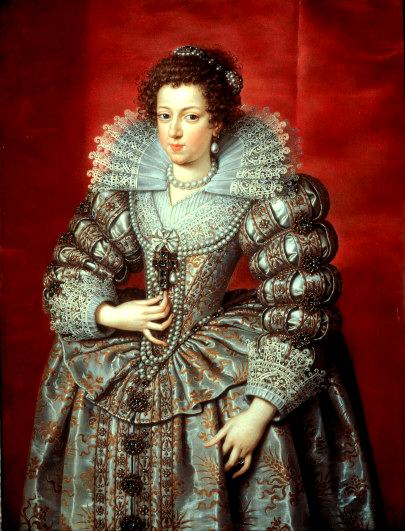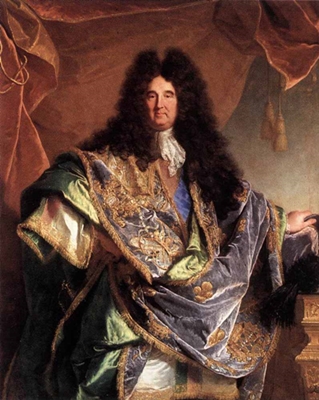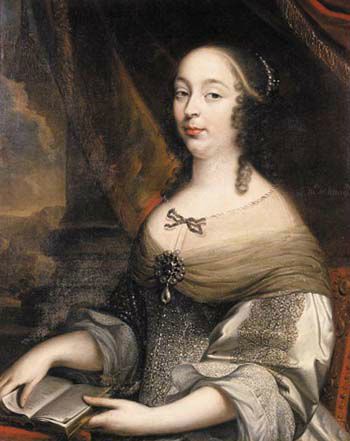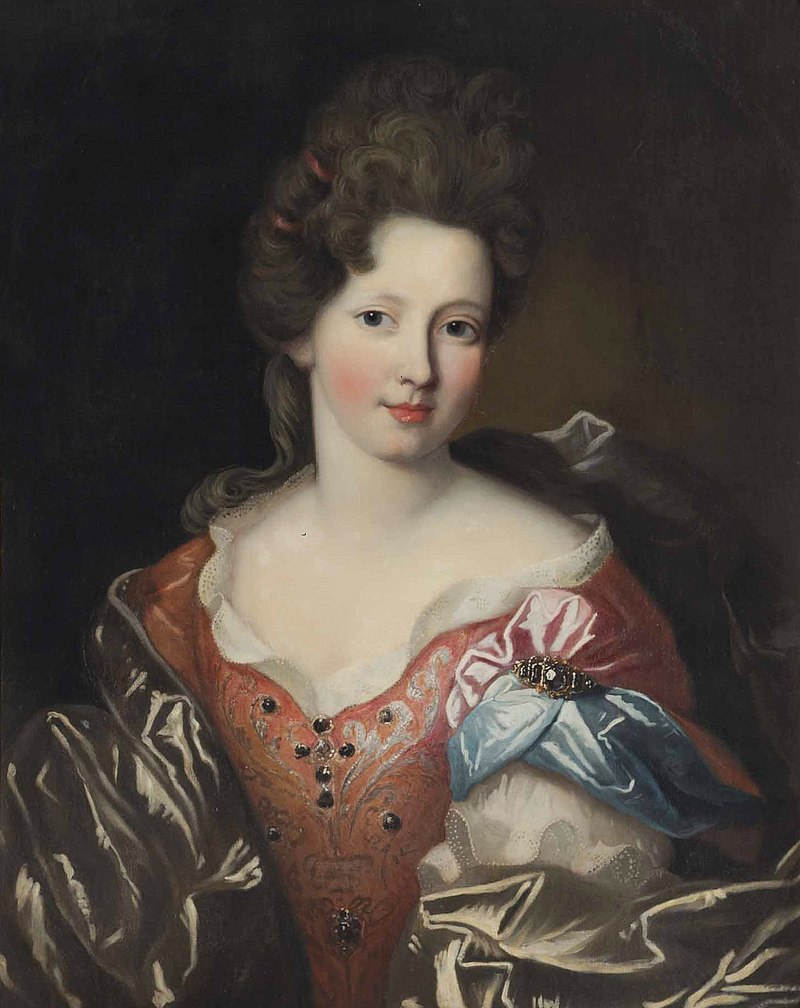Anne d’Autriche
Ana María Mauricia de Austria y Austria-Estiria or short Anne d’Autriche was born on 22 September 1601 as oldest daughter of Philip III of Spain and his second cousin and wife Margaret of Austria.

Anne received her first name in honour of her grandmother Anne of Austria, fourth wife of Philip II, her second name María in honour of the Virgin Mary. She received her third name Mauricia, because she was born on the day of Saint Maurice.
Little Anne held the titles Infanta of Spain and of Portugal, her papa being also King of Portugal, as well as that of Archduchess of Austria. Although she was born in Spain and part of the Spanish royal family, she was called of Austria, because the Spanish royals belonged to the House of Austria aka the Habsburgs and no distinction was commonly made between the Spanish Habsburgs and the Austrian Habsburgs.
In contrary to what was common practice, keeping children apart from the parents, the Infanta grew up in close proximity to her parents. Anne spent much of her childhood at the Royal Alcazar in Madrid, surrounded by her affectionate parents, who guided her education and made sure she was brought of god-fearing and devout. Anne was often taken to visit convents and churches, where she spend hours in awe of various relics and in prayer.
Little Anne was also very close to her siblings. Tragedy stuck the family as Anne’s mother died during the birth of her eight child in 1611. Margaret of Austria was only twenty-seven.
As the oldest of the siblings, Anne, despite her grief, started to take care of her younger siblings, who soon called her their mother. Around the same time Anne lost her mother, her father was in contact with the French court to arrange a double marriage. Anne ought to marry the new King of France, Louis XIII, and Louis’ sister Élisabeth ought to marry Anne’s brother Phillip, then the Prince of Asturias.
Louis XIII was of the same age as Anne. He just had become King of France after the assassination of his father Henri IV and his mother Marie de Médicis acted as his regent. As always when it comes to the marriages of Kings, love played no role. Marie de Médicis wanted to make France a bit more Spain-friendly and Philip III thought his daughter being Queen of France will be good for his interests. Anne and Louis were engaged as they were ten years old and had never seen each other before.

In order to become Queen of France, Anne had to renounce all succession rights to the Spanish crown for herself and her descendants by Louis. Her papa gave her a dowry of 500,000 livres, along with many beautiful gems and gowns…. but they put a bit of a loophole into the wedding contract. Louis XIII was not the healthiest and the Spanish court feared he might not be King of France for too long. In which case it was stipulated, that Anne, if left a childless widow, would return to Spain with all of her dowry and possessions and regain her rights to the Spanish crown… and it nearly came to that.
As bride and groom reached the age of fourteen, everything had been settled, also in regards of the marriage of their siblings. Anne and Louis were married by proxy in the Spanish Burgos on 18 October 1615 and on the same day Élisabeth de France was married by proxy to Anne’s brother in the French Bordeaux. The brides and grooms then travelled to the île des Faisans, an uninhabited river island in the Bidasoa river on the border of France and Spain.
There the brides were exchanged. Anne left the Spanish side for the French side as new Queen of the latter. Élisabeth left the French side for the Spanish as future Queen of the latter. The start of a tradition. Years later, Louis XIV met his bride Marie-Thérèse on the île des Faisans, some years later Charles II of Spain met his bride Marie-Louise there and some years later again, Louis XV met his intended bride Marie-Anne-Victoire d’Espagne there.
Anne and Louis married in person on 15 December the same year. The groom is a little shy, but does his best, the bride rather lovely the behold and in spirit. What could possibly go wrong?
Although both are rather young and don’t really have a clue what to do in regards of bedsports, the Regent, Louis’ mother, insisted that the marriage was to be made a proper one as soon as possible… which led to a disastrous wedding night. Both did not know what was expected of them, the shy Louis felt utterly humiliated most of the night, Anne was embarrassed by it all. Upon dawn Louis was firm in his decision not to repeat the deed for a while, it took four years until the next attempt, and was rather upset that his mother forced him to do the deed at all that night. Louis, as it was custom, visited his wife in the mornings and evenings, but that was it. No touching. No under-the-duvet-adventures.
Not an easy time for Anne. Most of the court did not care for her, Marie de Médicis continued to call herself Queen of France, as if she was the current Queen, with utter disregard to the new Queen, Louis was unsure what to think of Anne. He did not want to look a fool, but somehow that mostly happened when he was in her company. People annoyed him with talk of how France needed an heir…. but even if he wanted to try again…. how should he go about it without feeling embarrassed? At the same time, Anne secluded herself more and more from the court. She surrounded herself with Spanish ladies, spoke Spanish all day, which of course did not help to improve her French and led to more awkward moments of not understanding or not knowing what to say with her husband’s family. Anne continued to dress in Spanish fashion too, which the French ladies could not understand at all. She also had problems with the French etiquette and customs.

All in all Louis and Anne had a sort of very formal distance between them, which nobody really knew how to remedy…. until the Duc de Luynes came along. Louis XIII was in a conflict with his mother over her attempts to involve herself in ruling France. Louis didn’t like it at all and had his mother’s favourite Concino Concini assassinated. That caused quite the tension and talk. Louis was in a feeble situation and needed something to finally establish himself… like an heir…. but he was still avoiding his wife’s bed. The Duc de Luynes was eager to find a solution for the problem. He started by replacing the Spanish ladies with French ones, to encourage Anne to learn the language and customs, talked her into trying French fashion, which was way less prudish that her Spanish gowns, and arranged informal private meetings between Louis and Anne, so they might get to know each other a little.
In spring of 1619, Luynes then forced an even more informal meeting on the couple and made them share a bed. The King performed the deed and seemed to have enjoyed it a bit more than he did the first time. He also started to actually like his wife, at least it was noted that he was more affectionate and rather worried as Anne fell ill the same year.
Anne even became pregnant… but lost the child. They tried again, every once in a while. The Queen was not aware that she was pregnant as, on 14 March 1622, she amused herself with her ladies in the barely lit galleries of the Louvre and stumbled against something. She was taken to bed with a strong belly ache… some hours later the physicians told Louis that Anne had just given birth to an embryo a little over a month old.
Louis was furious. At Anne and also at her friend Madame de Luynes, who he blamed for the whole thing. The relationship between King and Queen reached a new low. The death of the Duc de Luynes, who had made sure both stay civil with each other, did the rest. One intrigue followed the next. Anne was tempted by the former Madame de Luynes who was now Madame de Chevreuse, after marrying her lover shortly after the death of her hubby, to involve herself in those intrigues…. and then the Duke of Buckingham ado made everything even worse.
Charles I of England married Louis’ sister Henriette-Marie in 1625. The Duke of Buckingham, Charles’ favourite, was sent to France and apparently fell in love with Anne. He was charged with escorting Henriette-Marie to England and as it was custom, the French court accompanied the bride to the border. Louis stayed in Paris, but Anne and the Queen Mother joined the bride for the voyage. As Amiens was reached, on 14 June, the advances Buckingham made towards Anne led Madame de Chevreuse to arrange a secret meeting between them in a secluded garden….

Nobody is quite sure what happened that night. According to Pierre de la Porte, Anne’s valet de chambre, the Duke’s advances reached a new height and Anne was heard to utter a cry. According to the Historiettes of Tallemant des Reaux, Buckingham tried to force himself upon Anne and while doing that scratched her thighs. Whatever happened, talk of it circulated through all of France and Europe. Some putting the blame on Buckingham and others saying Anne was to blame. Louis XIII was very angry and forbade Buckingham to set foot on French soil again.
In 1625, ten years after their marriage, there was still no heir and many had already given the thought up that there might be one at some point. If Anne and Louis would have no children, the crown of France would go to Louis’ brother Gaston. Louis XIII did not want that, at all. But what was he supposed to do? And what was Anne supposed to do? They were at a dead end.
After the Buckingham affair, constant ado about Cardinal Richelieu brought them ever further apart. Anne had no political say, but was in close contact with her Spanish family. Louis and Richelieu were not really fans of Spain at that point… and Anne had her problems with Richelieu.
Richelieu placed Madeleine du Fargis among Anne’s ladies. She was supposed to spy on her for him… but instead she became Anne’s favourite. In the meanwhile, there was constant plotting going on involving the Queen Mother and Gaston. Anne cooperated with them in one of those plots and as punishment Louis removed a lot of her favourite ladies in December 1630. Madame du Fargis was one of them. She fled to Brussels and letters were discovered in which was hinted that Anne was not opposed to marry Gaston should Louis XIII be removed from the throne…. Louis was again, of course, rather furious. Anne was questioned about the letters, confirmed the writing was that of Madame du Fargis, but denied any knowledge or approval of marriage talk between her and Gaston. Louis somewhat forgave her…
But then, in 1635, twenty-years after the wedding with still no heir in sight, France declared war on Spain and Anne was in serious trouble now.
The Queen of France entertained a secret exchange of letters with her brother Philip IV as well as with Spanish ambassador and the governor of the Spanish Netherlands. The correspondence was exchanged with the help of Anne’s valet Monsieur de La Porte and the Mesdames de Chevreuse and du Fargis. Some of the letters were of a rather delicate nature, for Anne made inquires in them which could be seen as her trying to get involved in support of Spain.
Cardinal Richelieu, who always had a close eye on Anne, got suspicious and ordered an investigation in regards of how close the contact between the Queen of France and her Spanish relatives was. The Cardinal picked the right people to be questioned and they admitted to have forwarded secret letters. Anne was thus called to be questioned. She denied that such things ever happened… but as the pressure got too much a couple of days later, she admitted it all.
Poor Anne was forced to sign a paper that opened her letters for inspection, meaning the Cardinal would read everything she wrote before it could be sent, she was forbidden to visit convents, what she often did, without first getting permission and was not allowed to be left unattended, meaning someone always had to be with her. Furthermore, pretty much all of her household was replaced with people loyal to King and Cardinal, who would of course report her every move.
 At that point, with the relationship of King and Queen being in such a state, pretty much nobody in France thought it could be repaired easily and an heir might be born… but then “a marvel when it was least expected“, as the Gazette called it, happened. A storm prevented Louis from a trip and he had to stop for the night at the very residence Anne stayed at during this time. There was no bed considered fit enough for a King to spent the night in… apart from that of Anne… and so a second pillow was placed on it and Louis crawled in. Bingo. After long years of nothing, Anne was pregnant again and this time everything went well. A healthy boy, who would soon become Louis XIV, was born on 5 September 1638.
At that point, with the relationship of King and Queen being in such a state, pretty much nobody in France thought it could be repaired easily and an heir might be born… but then “a marvel when it was least expected“, as the Gazette called it, happened. A storm prevented Louis from a trip and he had to stop for the night at the very residence Anne stayed at during this time. There was no bed considered fit enough for a King to spent the night in… apart from that of Anne… and so a second pillow was placed on it and Louis crawled in. Bingo. After long years of nothing, Anne was pregnant again and this time everything went well. A healthy boy, who would soon become Louis XIV, was born on 5 September 1638.
Another just as surprising marvel happened as Anne gave birth to another son, Philippe, on 21 September 1640. Louis XIII was beside himself with joy….but it still was not quite enough for Louis to really trust Anne again.
Louis XIII died 14 May 1643, the 33rd anniversary of his father’s death. As it was custom, Anne was named Regent for the young Louis XIV… but Louis XIII had a will set up before his demise, which limited Anne’s power and put a Regency Council into place, for Louis did not quite trust his wife with the running of a Kingdom. Such a thing was out of question for Anne. She managed to have Louis’ will overturned within days and had her son declare his confidence in her. Anne thus rules France as Regent along with Cardinal Mazarin, who she appointed Prime Minister much to the surprise of the court.
The Regent faced many difficulties from the start on. First there were those who did not think her capable and tried to undermine her. Then there were those who, after not being present in ages, flocked to court in an attempt to gain this or that favour by the means of positions. The there were also those who thought she should not be Regent. Those who disagreed with her and the Cardinal’s politics. Those who acted as if they supported her, but plotted against her at the same time in secret.

And then there was the Fronde, a series of civil wars in France between 1648 and 1653, with the Royal Family turning against each other and France fighting France. Anne feared for her life and that of her sons, fled Paris several times, led a nomadic life with her two little boys, always travelling from one place to the other… She could not be sure whom to trust, to whom she could entrust her children and there were plots with the goal of seizing her, imprison her in a convent and forcefully take the King and his brother from her custody.
As the whole mess was finally over, Louis XIV was old enough to be considered to be of age. Anne put the Regency down, but remained a valued member of the Council. She advised her son whenever needed, not just in matters of France, but also in matters of religion and behaviour… the latter mostly in regards of her son’s flirting with various young ladies.
France gained a new Queen, Anne’s niece Marie-Thérèse d’Autriche, in 1660 and with the death of Cardinal Mazarin, and the taking of power of Louis XIV, Anne began to withdraw slowly but surely from court.
Louis still cherished her advice, but at the same time Anne and her son quarrelled regularly. Anne was concerned about her son’s behaviour, especially when it came to the ladies again. In her mind, Louis ought to be a role model of piousness… but Louis had other things in mind. Dancing, hunting, comedies and balls, grand fetes, bedsports which did not involve his wife. A bit of a typical case of the older generation not understanding the desires of the younger generation. While her son turned more and more to earthly pleasures, Anne turned towards religion. She often retired to Val-de-Grâce, a church founded by her.
Anne had always enjoyed good health, but began to feel as if her days on earth were coming to an end. She was diagnosed with breast cancer shortly later. In an attempt to prolong her life, the royal physicians began to cut the tumour away, a little bit every day, without narcotics, until Anne had a hole in her chest. She was in unimaginable pain. Her physicians then considered to fill the hole with fresh pork, which without a doubt would have led to a bad infection, but luckily it did not come to that. Anne died, on 20 January 1666, before the plan could be executed. Yet her death was a slow one. Philippe hardly ever left her side, but Louis… he could not stand to remain in the room and had left it before their mother took her last breath. Being informed of her death by a councillor, who exclaimed “Ce fut une grande Reine!“, he replied solemnly “Non monsieur, plus qu’une grande Reine, elle fut un grand Roi.”






